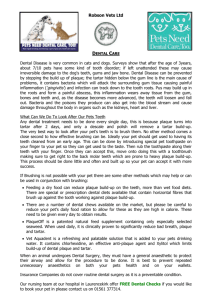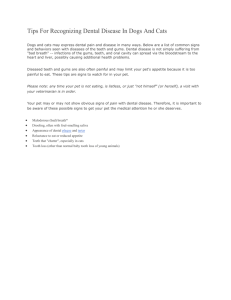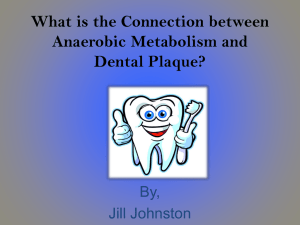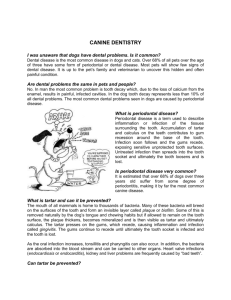CANINE DENTISTRY - Briarpointe Veterinary Clinic
advertisement
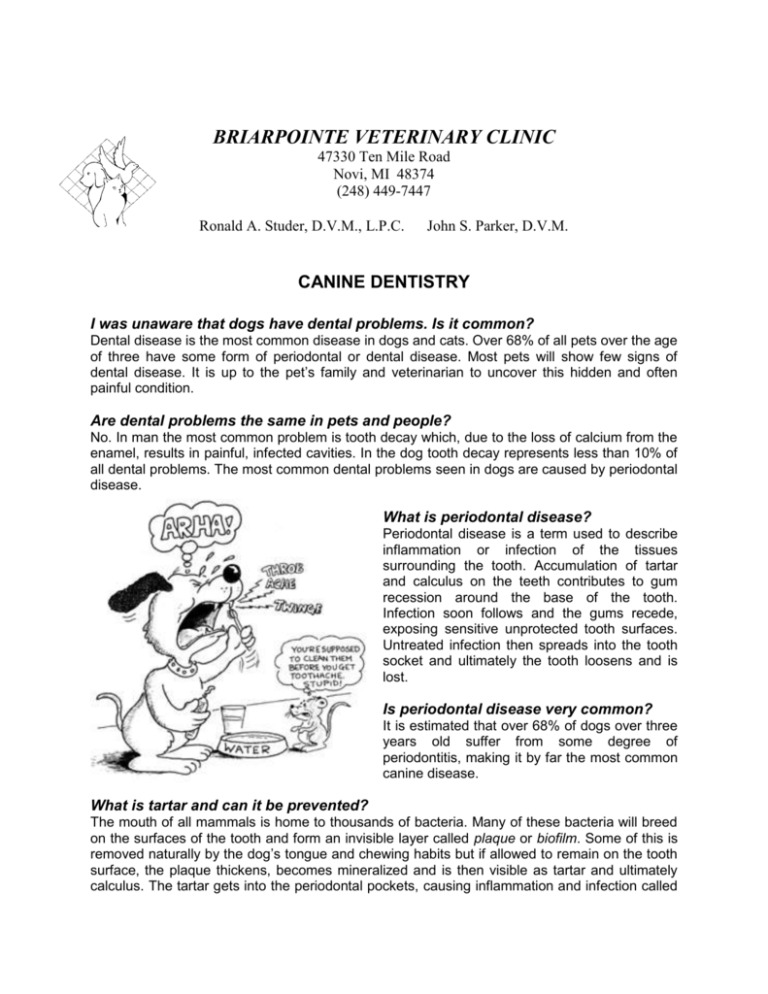
BRIARPOINTE VETERINARY CLINIC 47330 Ten Mile Road Novi, MI 48374 (248) 449-7447 Ronald A. Studer, D.V.M., L.P.C. John S. Parker, D.V.M. CANINE DENTISTRY I was unaware that dogs have dental problems. Is it common? Dental disease is the most common disease in dogs and cats. Over 68% of all pets over the age of three have some form of periodontal or dental disease. Most pets will show few signs of dental disease. It is up to the pet’s family and veterinarian to uncover this hidden and often painful condition. Are dental problems the same in pets and people? No. In man the most common problem is tooth decay which, due to the loss of calcium from the enamel, results in painful, infected cavities. In the dog tooth decay represents less than 10% of all dental problems. The most common dental problems seen in dogs are caused by periodontal disease. What is periodontal disease? Periodontal disease is a term used to describe inflammation or infection of the tissues surrounding the tooth. Accumulation of tartar and calculus on the teeth contributes to gum recession around the base of the tooth. Infection soon follows and the gums recede, exposing sensitive unprotected tooth surfaces. Untreated infection then spreads into the tooth socket and ultimately the tooth loosens and is lost. Is periodontal disease very common? It is estimated that over 68% of dogs over three years old suffer from some degree of periodontitis, making it by far the most common canine disease. What is tartar and can it be prevented? The mouth of all mammals is home to thousands of bacteria. Many of these bacteria will breed on the surfaces of the tooth and form an invisible layer called plaque or biofilm. Some of this is removed naturally by the dog’s tongue and chewing habits but if allowed to remain on the tooth surface, the plaque thickens, becomes mineralized and is then visible as tartar and ultimately calculus. The tartar gets into the periodontal pockets, causing inflammation and infection called gingivitis. The inflamed gum tissue starts to recede until ultimately the tooth socket is infected and the tooth is lost. As the oral infection increases, tonsillitis and pharyngitis can also occur. In addition, the bacteria are absorbed into the blood stream and can be carried to other organs. Heart valve infections (endocardiosis or endocarditis), kidney and liver problems are frequently caused by “bad teeth”. Can tartar be prevented? Plaque becomes mineralized in some dogs much quicker than in others. Special canine chew toys as well as feeding specifically-formulated dental diets may help reduce tartar build up, as does regular home care such as tooth brushing. Today there are many products designed to reduce tartar in our dogs such as American-made rawhide products. We can recommend a size and type appropriate for your pets. Will feeding dry food remove tartar? Once tartar has formed it will be necessary to remove it by professional scaling and polishing under anesthesia. Pet food manufacturers have recently developed new dental diets that can help reduce the formation of plaque and tartar in your pet. What is involved with a dental cleaning for my dog? The goal of dental scaling and polishing is to remove the tartar and invisible plaque. We will perform preanesthetic blood tests to ensure that kidney and liver function are satisfactory for anesthesia. Sometimes antibiotic treatment is instituted before a full dental prophylaxis is carried out. We will discuss the specific pre-dental recommendations for your pet. Tooth scaling will be performed using both hand scalers and ultrasonic cleaning equipment to remove tartar both above and below the gum line. The tartar beneath the gum line causes the most significant gum recession. The teeth are then polished in order to help prevent subsequent plaque build-up. It may be necessary to carry out other procedures such as extractions at the same time. Special applications such as fluoride, antibiotic preparations and cleaning compounds may be indicated to decrease tooth sensitivity, strengthen enamel and reduce plaque accumulation and bacterial infection. These procedures will be fully discussed both before your pet’s dental cleaning and when you bring your pet in for the procedure. Since it can be difficult to predict the extent of dental disease in advance of the procedure we ask in advance for permission to perform any treatment that may be necessary for your pet during the anesthetic procedure. . Do I have to make an appointment for my dog to have a dental scaling and polishing? Yes. We will perform pre-anesthetic blood tests, examine your pet for any other underlying disorders prior to the procedure, and determine if antibiotic treatment should be started in advance. How can I prevent tartar accumulation after the procedure? Plaque and tartar begin forming in as little as six hours after your pet’s dental cleaning. A home dental care program is important for all pets. We will provide you with detailed instructions on how to provide home care to help keep your pet’s teeth clean. In addition, there is a vaccine available that may be of help in preventing gingivitis and periodontal disease. Can I use human toothpaste? No! Human dentifrice or toothpaste should not be used in dogs. These are foaming products and are not meant to be swallowed. Additionally, many types of human toothpaste contain sodium, which may cause problems in some pets. We can recommend a flavored dentrifice to help prevent plaque buildup and gingivitis. Can I use my pet’s annual health screen results as a pre-anesthetic blood screen? Yes, in most instances if your pet’s annual health screen blood tests are/were normal, the tests will not need to be repeated if the procedure is done within 3 months of when the tests were initially run. Pet _____________________ Dental Report Card Date____________________ Dr. Studer Normal Dr. Parker Home care will help keep teeth and gums healthy. No signs of plaque or tartar. --------------------------------------------------------------------------------------------------------------------Stage 2 Plaque/tartar with inflammation of gingival margins. Inflammed gingival tissue has low grade bacterial infection. Gums likely to be irritated and sore Needs Professional cleaning. We recommend scheduling a teeth cleaning within the next 1-6 months. --------------------------------------------------------------------------------------------------------------------Stage 3 Severe plaque/tartar with invasion into the periodontal pocket, swelling of gingival and bacterial infection. Painful gums. Needs professional cleaning. We recommend scheduling a teeth cleaning as soon as possible. --------------------------------------------------------------------------------------------------------------------Stage 4 Severe infection of periodontal Pocket and regression of gingival margin with tooth root exposure. Infected gingival spreading bacteria into bloodstream. High risk of infection to other organs. Painful gums and teeth. Needs Professional cleaning and possible extraction(s). We recommend scheduling these procedures immediately. -------------------------------------------------------------------------------------------------------------------Stage 5 Severe gingival infection and infection of tooth roots involving multiple teeth. High risk of infection spread to other organs through bloodstream. Loose, painful teeth. Needs professional cleaning, multiple extractions and periodontal therapy. We recommend scheduling these procedures immediately.
